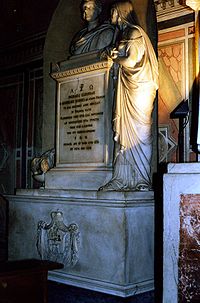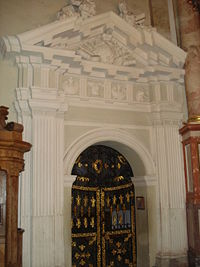
Oginski family
Encyclopedia
Ogiński was a noble family of Lithuania
and Poland
(later, the Polish-Lithuanian Commonwealth
), member of The Princely Houses of Poland
.
They were most likely of Rurikid stock, related to Chernihiv
Knyaz
family, and originated from the Smolensk
region, incorporated into the Grand Duchy of Lithuania
around 14th century. The family bears its name from Uogintai (in present day Kaišiadorys district of Lithuania
), a major estate of the family in Lithuania granted to precursor of the family Knyaz Dmitry Hlushonok (d. 1510) by Grand Duke of Lithuania Alexander
in 1486. An important family in the Grand Duchy of Lithuania
, the family had produced many important officials of the state, as well as several notable musicians. The Ogiński clan's political stronghold was the Vitebsk Voivodeship, where a palace was built in the first half of the 17th century by Samuel Ogiński; until the beginning of the 19th century, it was the largest public building in the city of Vitebsk
.
On September 18, 1711 Bishop Bogusław Gosiewski, sold the town of Maladzyechna
the Ogiński family. Among the owners of the area were Kazimierz Ogiński and Tadeusz Ogiński, the Castellan
of Trakai
. The Ogiński family made it one of the main centres of their domain. They erected a new, classicist palace with notable frescoes, as well as a late renaissance church. In 1783 the family received the title of Prince
from the Holy Roman Emperor
.
In 1882 the villages Zalavas
and Kavarskas
were bought by Michał Ogiński, an heir to the Ogiński family who had owned it in the 18th century. They also temporarily possessed Siedlce
. They were the sponsors of Orthodox editions in Ruthenian
and Slavonic
languages. Orthodox publicists called the clan of Oginski "the bastion of Orthodox faith". The last orthodox magnate
, Marcjan Aleksander Ogiński had to choose between Roman Catholic and Greek-Catholic Church .


Lithuania
Lithuania , officially the Republic of Lithuania is a country in Northern Europe, the biggest of the three Baltic states. It is situated along the southeastern shore of the Baltic Sea, whereby to the west lie Sweden and Denmark...
and Poland
Poland
Poland , officially the Republic of Poland , is a country in Central Europe bordered by Germany to the west; the Czech Republic and Slovakia to the south; Ukraine, Belarus and Lithuania to the east; and the Baltic Sea and Kaliningrad Oblast, a Russian exclave, to the north...
(later, the Polish-Lithuanian Commonwealth
Polish-Lithuanian Commonwealth
The Polish–Lithuanian Commonwealth was a dualistic state of Poland and Lithuania ruled by a common monarch. It was the largest and one of the most populous countries of 16th- and 17th‑century Europe with some and a multi-ethnic population of 11 million at its peak in the early 17th century...
), member of The Princely Houses of Poland
The Princely Houses of Poland
The Princely Houses of Poland differed from other princely houses in Europe. Most importantly, Polish nobility could not be granted nobility titles by the Polish kings in the Polish-Lithuanian Commonwealth...
.
They were most likely of Rurikid stock, related to Chernihiv
Chernihiv
Chernihiv or Chernigov is a historic city in northern Ukraine. It is the administrative center of the Chernihiv Oblast , as well as of the surrounding Chernihivskyi Raion within the oblast...
Knyaz
Knyaz
Kniaz, knyaz or knez is a Slavic title found in most Slavic languages, denoting a royal nobility rank. It is usually translated into English as either Prince or less commonly as Duke....
family, and originated from the Smolensk
Smolensk
Smolensk is a city and the administrative center of Smolensk Oblast, Russia, located on the Dnieper River. Situated west-southwest of Moscow, this walled city was destroyed several times throughout its long history since it was on the invasion routes of both Napoleon and Hitler. Today, Smolensk...
region, incorporated into the Grand Duchy of Lithuania
Grand Duchy of Lithuania
The Grand Duchy of Lithuania was a European state from the 12th /13th century until 1569 and then as a constituent part of Polish-Lithuanian Commonwealth until 1791 when Constitution of May 3, 1791 abolished it in favor of unitary state. It was founded by the Lithuanians, one of the polytheistic...
around 14th century. The family bears its name from Uogintai (in present day Kaišiadorys district of Lithuania
Lithuania
Lithuania , officially the Republic of Lithuania is a country in Northern Europe, the biggest of the three Baltic states. It is situated along the southeastern shore of the Baltic Sea, whereby to the west lie Sweden and Denmark...
), a major estate of the family in Lithuania granted to precursor of the family Knyaz Dmitry Hlushonok (d. 1510) by Grand Duke of Lithuania Alexander
Alexander Jagiellon
Alexander of the House of Jagiellon was the Grand Duke of Lithuania and later also King of Poland. He was the fourth son of Casimir IV Jagiellon...
in 1486. An important family in the Grand Duchy of Lithuania
Grand Duchy of Lithuania
The Grand Duchy of Lithuania was a European state from the 12th /13th century until 1569 and then as a constituent part of Polish-Lithuanian Commonwealth until 1791 when Constitution of May 3, 1791 abolished it in favor of unitary state. It was founded by the Lithuanians, one of the polytheistic...
, the family had produced many important officials of the state, as well as several notable musicians. The Ogiński clan's political stronghold was the Vitebsk Voivodeship, where a palace was built in the first half of the 17th century by Samuel Ogiński; until the beginning of the 19th century, it was the largest public building in the city of Vitebsk
Vitebsk
Vitebsk, also known as Viciebsk or Vitsyebsk , is a city in Belarus, near the border with Russia. The capital of the Vitebsk Oblast, in 2004 it had 342,381 inhabitants, making it the country's fourth largest city...
.
On September 18, 1711 Bishop Bogusław Gosiewski, sold the town of Maladzyechna
Maladzyechna
Maladzyechna , is a city in the Minsk Voblast of Belarus, an administrative centre of the Maladzyechna district . It has 98,514 inhabitants and is located 72 km northwest of Minsk. Located on the Usha River, it has been a settlement since 1388 when it was part of the Grand Duchy of Lithuania...
the Ogiński family. Among the owners of the area were Kazimierz Ogiński and Tadeusz Ogiński, the Castellan
Castellan
A castellan was the governor or captain of a castle. The word stems from the Latin Castellanus, derived from castellum "castle". Also known as a constable.-Duties:...
of Trakai
Trakai
Trakai is a historic city and lake resort in Lithuania. It lies 28 km west of Vilnius, the capital of Lithuania. Because of its proximity to Vilnius, Trakai is a popular tourist destination. Trakai is the administrative centre of Trakai district municipality. The town covers 11.52 km2 of...
. The Ogiński family made it one of the main centres of their domain. They erected a new, classicist palace with notable frescoes, as well as a late renaissance church. In 1783 the family received the title of Prince
Prince
Prince is a general term for a ruler, monarch or member of a monarch's or former monarch's family, and is a hereditary title in the nobility of some European states. The feminine equivalent is a princess...
from the Holy Roman Emperor
Holy Roman Emperor
The Holy Roman Emperor is a term used by historians to denote a medieval ruler who, as German King, had also received the title of "Emperor of the Romans" from the Pope...
.
In 1882 the villages Zalavas
Zalavas
Zalavas is a small village in Švenčionys district municipality, Lithuania. It is located on the Mera river near the Lithuanian state border with Belarus. According to the 2001 census, it had 173 residents. It is the birthplace of Marshal Józef Piłsudski, who later became Chief of State of...
and Kavarskas
Kavarskas
Kavarskas , with a population of only 700, is the fourth smallest city in Lithuania. The Šventoji River flows through the town. In 1956 near Kavarskas a water lifting station was built and part of the Šventoji River's water was channeled to the Nevėžis River...
were bought by Michał Ogiński, an heir to the Ogiński family who had owned it in the 18th century. They also temporarily possessed Siedlce
Siedlce
Siedlce ) is a city in eastern Poland with 77,392 inhabitants . Situated in the Masovian Voivodeship , previously the city was the capital of a separate Siedlce Voivodeship ....
. They were the sponsors of Orthodox editions in Ruthenian
Ruthenian language
Ruthenian, or Old Ruthenian , is a term used for the varieties of Eastern Slavonic spoken in the Grand Duchy of Lithuania and later in the East Slavic territories of the Polish–Lithuanian Commonwealth....
and Slavonic
Old Church Slavonic
Old Church Slavonic or Old Church Slavic was the first literary Slavic language, first developed by the 9th century Byzantine Greek missionaries Saints Cyril and Methodius who were credited with standardizing the language and using it for translating the Bible and other Ancient Greek...
languages. Orthodox publicists called the clan of Oginski "the bastion of Orthodox faith". The last orthodox magnate
Magnate
Magnate, from the Late Latin magnas, a great man, itself from Latin magnus 'great', designates a noble or other man in a high social position, by birth, wealth or other qualities...
, Marcjan Aleksander Ogiński had to choose between Roman Catholic and Greek-Catholic Church .

Notable family members
- Aleksander Ogiński (? - 1667), last orthodox senator of General sejmGeneral sejmThe general sejm was the parliament of Poland for four centuries from the late 15th until the late 18th century.-Genesis:The power of early sejms grew during the period of Poland's fragmentation , when the power of individual rulers waned and that of various councils and wiece grew...
, Banner BearerChorążyChorąży or Khorunzhyi is a military rank in Poland, Ukraine and some neighboring countries. A chorąży was once a knight who bore a standard — the emblem of an armed troop, a province , a land , a duchy, or the kingdom...
of Trakai VoivodeshipTrakai VoivodeshipTrakai Voivodeship, Trakai Palatinate, or Troki Voivodeship , was a unit of administrative division and local government in the Grand Duchy of Lithuania from 1413 until 1795.-History:...
. - Samuel Ogiński (? - 1657), Trakai bailiffBailiffA bailiff is a governor or custodian ; a legal officer to whom some degree of authority, care or jurisdiction is committed...
. - Marcjan Aleksander OgińskiMarcjan Aleksander OginskiMarcjan Aleksander Ogiński was a nobleman, a military commander and a statesman of the Grand Duchy of Lithuania in the Polish-Lithuanian Commonwealth. He advanced to colonel in 1657, served as Voivod of Trakai and Grand Chancellor of Lithuania...
(1632–1690), Lithuanian senator and military commander. - Ignacy Ogiński Grand marshall of Lithuania.
- Michał Kazimierz Ogiński (1730–1800), Lithuanian senator and composer.

- Michał Kleofas Ogiński (1765–1833), Polish-Lithuanian senator and composer, author of the polonaise Farewell to the Fatherland.
- Tadeusz Franciszek OgińskiTadeusz Franciszek OginskiPrince Tadeusz Franciszek Andrzej Ogiński was a szlachcic from the Polish-Lithuanian Commonwealth.He was Grand Clerk of Lithuania since 1737, castellan of Trakai since 1744, voivode of Trakai since 1770, starost oszmiański, wierzbowski and przewalski....
(1712–1783), Lithuanian senator and speaker of the Sejm. - Grzegorz Antoni OgińskiGrzegorz Antoni OgińskiGrzegorz Antoni Ogiński was a Polish-Lithuanian Hetman and governor-general of the Duchy of Samogitia from 1698. Ogiński was one of the leaders of the uprising against the Sapieha Lithuanian magnates. He was successful in the Lithuanian Civil War which culminated in the Battle of Olkieniki on...
- Gabriel Ogiński
See also
- Grand Duchy of LithuaniaGrand Duchy of LithuaniaThe Grand Duchy of Lithuania was a European state from the 12th /13th century until 1569 and then as a constituent part of Polish-Lithuanian Commonwealth until 1791 when Constitution of May 3, 1791 abolished it in favor of unitary state. It was founded by the Lithuanians, one of the polytheistic...
- Lithuanian nobility
- List of szlachta
External links
- http://oginski.iatp.by/images/tree.jpg Family tree of Michał Kleofas Ogiński, since 14th century.

